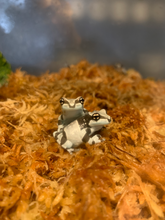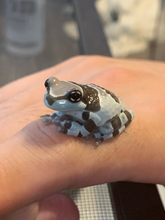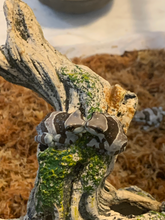
Highlights
- Great beginner Tree Frog
- Easy to Keep
- Rather large frog species
- Can be kept in groups
- MILK PATTERN!
Name: These frogs are most commonly called ‘Amazon Milk Frogs‘ presently, due to the milky white secretions that are released from the frog’s back when threatened (this rarely occurs with captive bred animals). In the past, Amazon Milk Frogs have also been called Amazon Cave Frogs, and Gold Mission Frogs, due to black markings on their eyes that resemble crucifixes. The Amazon Milk Frog's scientific name is Trachycephalus resinifictrix.
Recommended Terrarium Size: Being large frogs, Amazon Milk Frogs require a large enclosure. A 29g aquarium or 18x18x24 Terrarium is a good sized enclosure for 2-4 Amazon Milk Frogs. The enclosure should provide plenty of perching areas, such as wood branches or vines, as well as live plants or fake plants. A large water bowl is a necessity. For younger Amazon Milk Frogs, moist paper towel or long fiber sphagnum moss is preferred. Be careful when using sphagnum moss as it can cause impaction. Flatten it! Adult Amazon Milk Frogs can also be kept above water instead of a substrate. All substrate should be changed frequently. Amazon Milk Frogs are big frogs, and as such, can make a big mess. Water bowls should be cleaned daily and scrubbed out with hot water. Change the substrate at least once a week, and clean the enclosure and decor with a 5% bleach solution. If paper towel is used as a substrate, it should be cleaned daily.
Temperature: They can tolerate temperatures between 70-85F, and seem very tolerant of temperature swings. Ideally, keep Amazon Milk Frogs in the mid/high 70s. A 5-10F temperature drop at night is ideal. A good Thermometer and Hygrometer is recommended to keep track of environmental conditions.
Humidity: In the wild, precipitation and humidity fluctuates based on season, with a heavy rainy season in the early part of the year. Adult Amazon Milk Frogs can handle a wide range of humidity levels, but prefer humidity levels around 50-70% with plenty of ventilation/air movement. Young Amazon Milk Frogs do much better with 70-80% humidity, and some air movement. Moist, stagnant air is a big no-no with milk frogs, while very young animals dry out easily. Routine spraying and a full screen top will aid in providing proper humidity levels. Some keepers elect to keep Amazon Milk Frogs over water to aid in maintaining humidity.
Size: Adult Amazon Milk frogs can measure from 3” to 5”, with females being larger than males. Amazon Milk Frogs will continue to grow throughout their lives, and older animals can be quite large. The amazon milk frogs sold measure about 1.5″ long, and are eating 1/4″ crickets.
Age: Captive life span of these frogs is unknown, but suspected to be in the 5-10 year range, based on experience with similar species. Amazon milk frogs are 8-12 weeks old when sold by us.
Feeding: Amazon Milk Frogs are voracious eaters, consuming anything that moves and fits into their mouth. A staple diet of appropriately sized crickets is a great place to start. Add other feeder insects such as wax worms, roaches, horn worms, and meal worms, with the occasional pinky mouse appreciated. All feeder insects should be dusted with the proper vitamin/calcium supplement.
Sexing: Amazon Milk Frogs are generally sexable by 8-10 months of age. Females are larger and more rotund, while males are harder to distinguish as their vocal sacs are typically hidden by folds. Males also develop slightly swollen nupital pads on their front feet which aid in holding on to the female - these are typically visible during the breeding season. All frogs sold by us are unsexable.
Color/Pattern: Amazon Milk Frogs start out life at gray froglets with black and white banded legs. After a couple weeks, this gray body changes into a contrasting white and black banding pattern. After 6-8 months, the black bands may expand and become more of a gray color. A slight tan/brown color may sneak in on older animals. Milk frogs have a bright blue mouth. The area around their nostrils and toes can appear blue, as well.
Social Behavior: These frogs do great in groups. Overly amorous males may harass females on occasional, but Amazon Milk Frogs typically coexist peacefully in groups.
Breeding: Amazon Milk Frogs are not exceptionally difficult to breed, but can be difficult to breed consistently. Seasonal cycling, coupled with a large water volume and heavy feeding, can encourage breeding. Each female will lay between 300-1000 eggs, which quickly develop into voracious tadpoles that eat A LOT! After about 2 months in the water, the tadpole morph into dime to penny size froglets, which are initially gray in color.
Natural Range: Brazil, Colombia, Venezuela, Trinidad, Tobago, French Guiana, British Guyana, Ecuador, Peru, and Bolivia. Basically, Amazon Milk Frogs can be found throughout the Amazonian Basin, below 800m in elevation.
History in the Hobby: Amazon Milk Frogs are fairly well established in the US Herp hobby. Captive bred frogs are quite common nowadays.
A Special Note on Shedding: All frogs and toads shed, but they don't always do it in public! Amazon Milk Frogs are not shy about it whatsoever, and will typically shed at least once a week. They'll develop a shiny appearance for a few hours, before using their legs to peel off the old skin, then eat it. During this time, the milk frog will generally hang out at the bottom of the tank. Do not be alarmed - this is completely normal behavior, even though it looks a little strange!









